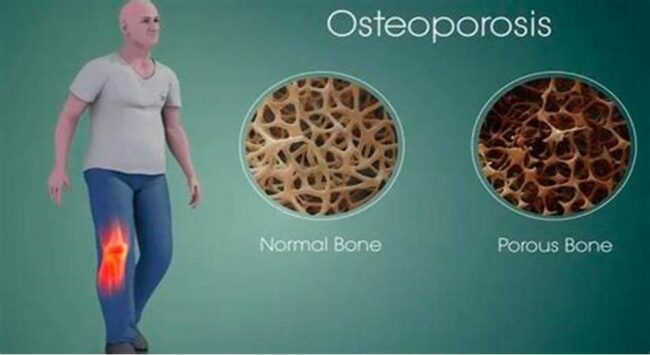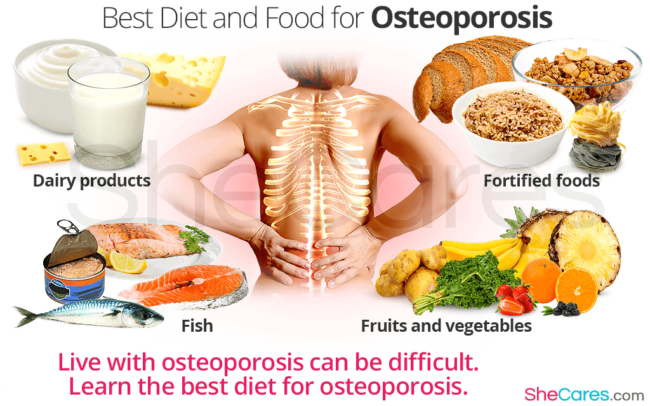
Osteoporosis is a common bone disease that affects millions of people around the world. It is characterized by low bone density and deterioration of bone tissue, leading to fragile and brittle bones. Osteoporosis can increase the risk of fractures and falls, which can have serious consequences, especially for older individuals.
Diagnosing osteoporosis is crucial in order to prevent further bone loss and reduce the risk of fractures. A bone mineral density test, also known as a DXA scan, is the most common method used to diagnose osteoporosis. This test measures the amount of minerals, such as calcium, in your bones and compares it to the average bone density of a healthy young adult. If your bone density is significantly lower than the average, you may be diagnosed with osteoporosis.
Preventing osteoporosis is possible through a combination of lifestyle changes and medical interventions. Engaging in regular weight-bearing exercises, such as walking or dancing, can help strengthen your bones and improve your balance. It is also important to consume a diet rich in calcium and vitamin D, as these nutrients play a crucial role in maintaining strong and healthy bones.
Incorporating calcium-rich foods, such as dairy products, leafy greens, and fortified cereals, into your diet can help ensure that you are getting enough calcium. Additionally, getting enough sunlight and incorporating vitamin D-rich foods, like fatty fish and egg yolks, can help your body absorb and utilize calcium more effectively.
While a healthy diet and exercise are important aspects of preventing osteoporosis, it is also crucial to avoid certain lifestyle choices that can accelerate bone loss. Limiting alcohol consumption, quitting smoking, and reducing caffeine intake can all help protect your bones and reduce the risk of osteoporosis.
By taking steps to diagnose osteoporosis early, making lifestyle changes, and following a bone-healthy diet, you can reduce your risk of fractures and maintain strong and healthy bones as you age. It is important to consult with your healthcare provider for personalized recommendations and to discuss any concerns you may have about osteoporosis.
Signs of osteoporosis
Osteoporosis is a condition that weakens the bones, making them more susceptible to fractures. It often develops slowly over time, with no symptoms or noticeable signs in the early stages. However, as the condition progresses, certain signs may become apparent. These signs include:
1. Fractures: Osteoporosis can make bones so weak that even a minor bump or fall can cause a fracture. Fractures of the spine, hip, or wrist are common in people with osteoporosis.
2. Loss of height: As osteoporosis affects the vertebrae in the spine, it can lead to a loss of height over time. This may result in a stooped posture or a hunched appearance.
3. Back pain: Compression fractures in the spine can cause severe back pain, which may worsen with movement or when lifting heavy objects.
4. Rounded shoulders: The weakening of the bones in the spine can cause the shoulders to become rounded or hunched forward.
5. Brittle nails: Osteoporosis can affect the health of the nails, making them brittle and more prone to breakage.
6. Receding gums: In some cases, osteoporosis can also affect the bones that support the teeth, leading to receding gums and tooth loss.
If you experience any of these signs or have concerns about your bone health, it is important to consult with a healthcare professional for an evaluation and appropriate diagnosis.
Diagnosis of osteoporosis
Diagnosing osteoporosis involves a combination of medical history, physical examination, and tests that measure bone density.
A medical history, including information about previous fractures, family history of osteoporosis, and lifestyle factors such as smoking and alcohol consumption, can provide important clues about a person’s risk for developing osteoporosis.
During a physical examination, a healthcare provider may look for signs of osteoporosis, such as loss of height or a rounded upper back. They may also perform tests to assess balance and coordination, as falls are a common cause of fractures in people with weak bones.
The most accurate way to diagnose osteoporosis is through a bone density test. This test, also known as a DXA scan, measures the amount of mineral in the bones and compares it to norms for age and sex. It is a painless and non-invasive procedure that is usually performed on the hip and spine.
In addition to the DXA scan, other tests may be recommended to help evaluate a person’s risk of fracture. These tests can include blood tests to measure calcium and Vitamin D levels, as well as imaging tests like X-rays or MRI scans to look for signs of fractures or other bone problems.
A comprehensive diagnosis of osteoporosis often involves a team of healthcare professionals, including a primary care provider, endocrinologist, and radiologist. The results of these tests and evaluations can help determine the severity of osteoporosis and guide treatment decisions.
Early diagnosis is important because it allows for early intervention and treatment, which can help prevent fractures and maintain bone strength. If you are at risk for osteoporosis, it is important to talk to your healthcare provider about appropriate diagnostic tests and steps you can take to support bone health.
Prevention of osteoporosis: diet and exercise

Eating a healthy diet and participating in regular exercise can play a crucial role in preventing osteoporosis.
When it comes to diet, it is important to consume foods that are rich in calcium and vitamin D. Calcium helps to build strong bones, while vitamin D helps the body to absorb calcium. Good sources of calcium include milk, cheese, yogurt, and leafy green vegetables such as broccoli and kale. Vitamin D can be obtained from exposure to sunlight as well as from foods like fatty fish and fortified dairy products.
In addition to calcium and vitamin D, it is also important to include foods that are rich in other nutrients like magnesium, potassium, and vitamin C. These nutrients can help to support overall bone health. Foods that contain magnesium include nuts, seeds, and whole grains, while fruits, vegetables, and legumes are good sources of potassium and vitamin C.
Exercise, particularly weight-bearing and resistance exercises, can also help to prevent osteoporosis. Weight-bearing exercises like walking, jogging, and dancing, as well as resistance exercises like yoga and weightlifting, can help to strengthen bones and improve overall bone density. It is recommended to engage in at least 30 minutes of moderate-intensity exercise most days of the week.
It is important to note that prevention strategies for osteoporosis should be tailored to individual needs and should be done in consultation with a healthcare professional. By maintaining a healthy diet and participating in regular exercise, individuals can take proactive steps to reduce their risk of developing osteoporosis and promote overall bone health.
| Calcium-rich Foods | Vitamin D Sources | Magnesium Sources | Potassium and Vitamin C Sources |
|---|---|---|---|
| Milk | Fatty fish (e.g. salmon, mackerel) | Nuts | Fruits |
| Cheese | Fortified dairy products | Seeds | Vegetables |
| Yogurt | Exposure to sunlight | Whole grains | Legumes |
| Leafy green vegetables |
Question-answer:
What is osteoporosis?
Osteoporosis is a condition characterized by a decrease in bone density, causing bones to become weak and brittle.
How is osteoporosis diagnosed?
Osteoporosis is typically diagnosed through a bone mineral density test (DXA scan), which measures the density of your bones.
What are the risk factors for osteoporosis?
There are several risk factors for osteoporosis, including age, gender, family history, low calcium intake, smoking, excessive alcohol consumption, and sedentary lifestyle.
Can osteoporosis be prevented?
Yes, there are several lifestyle changes that can help prevent osteoporosis, such as consuming a calcium-rich diet, getting regular exercise, avoiding smoking and excessive alcohol consumption, and taking certain medications if necessary.
What diet can help prevent osteoporosis?
A diet rich in calcium and vitamin D is important for preventing osteoporosis. Some examples of calcium-rich foods include dairy products, leafy green vegetables, and fortified foods. Vitamin D can be obtained from sunlight, oily fish, and fortified foods.
What is osteoporosis?
Osteoporosis is a medical condition characterized by a decrease in bone density, making the bones weak and prone to fractures.
Reviews
Emily Brown
I found this article on osteoporosis really informative and helpful. As a woman, I know that osteoporosis is a serious condition that primarily affects women as they age. The article provided a clear explanation of how osteoporosis is diagnosed and the importance of early detection. I learned that a bone density test is crucial for diagnosis and can help identify the risk of fractures. The article also emphasized the significance of prevention and maintaining a healthy lifestyle. I appreciate the specific recommendations for exercises that can help improve bone strength, like weight-bearing exercises and resistance training. It’s great to know that even simple activities like walking and dancing can be beneficial. Diet plays a vital role in preventing osteoporosis, and the article provided valuable information about the types of foods and nutrients essential for strong bones. I was particularly interested in the role of calcium and vitamin D in bone health. Overall, this article served as a wake-up call for me to take my bone health seriously. It’s essential to be proactive in preventing osteoporosis by staying physically active, eating a nutrient-rich diet, and regularly checking bone density. I would definitely recommend this article to other women who want to learn more about osteoporosis and take steps to protect their bone health.
PinkFairy
As a female reader, I found this article on osteoporosis to be very informative and helpful. Osteoporosis is a health concern that many women, like myself, worry about as we age. The article offers a detailed explanation of what osteoporosis is, its causes, and the importance of early diagnosis. I appreciate that the article also provides practical tips on prevention, such as regular exercise and a balanced diet rich in calcium and vitamin D. It’s reassuring to know that there are steps I can take to minimize the risk of developing osteoporosis. The section on diet was particularly interesting to me. It not only explains the importance of calcium and vitamin D but also suggests specific foods that are beneficial for bone health. I will definitely be incorporating more leafy greens, dairy products, and fortified cereals into my diet. Overall, I found this article to be a valuable resource for women concerned about osteoporosis. It is easy to understand, well-researched, and offers practical advice for prevention. I would highly recommend it to anyone looking to learn more about osteoporosis and how to maintain strong, healthy bones.
James Johnson
As a female reader, I found this article on osteoporosis extremely informative. It provided a comprehensive overview of the disease, including its causes, symptoms, and risk factors. I appreciate the emphasis on the importance of early diagnosis and prevention through lifestyle changes such as regular exercise and a balanced diet. The article also discussed the role of calcium and vitamin D in maintaining bone health, which resonated with me as I am always looking for ways to improve my diet to protect my bones. I found the suggested dietary changes and food sources of calcium and vitamin D very helpful. The tips on incorporating weight-bearing exercises into my routine were also practical and easy to implement. The section on screening and diagnosis was particularly enlightening. I now understand the significance of bone density testing and the different methods available. The information provided on fracture risk assessment tools was useful, as it gave me a better understanding of my own risk level. Overall, this article has empowered me to take control of my bone health and make informed decisions about preventing and managing osteoporosis. I will definitely be implementing the suggestions outlined in the article and continue to educate myself on this important topic. Thank you for providing such valuable information!
